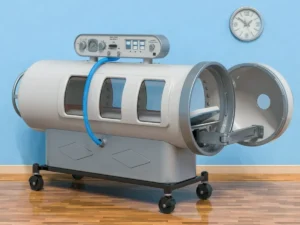Hydrogen is odorless, tasteless, and colorless. It is non-flammable at concentrations below 4-4.6% and non-toxic. It is also passive, not involved in any biochemical reactions in the body. It is the most common element in nature and at the same time the smallest.
It is thanks to its small size, exceptionally precise action and lack of side effects that hydrogen becomes the best antioxidant for us. Unlike other antioxidants, it has the ability to move freely into the interior of cells, including the mitochondria themselves. It is also a particularly effective scavenger of the most dangerous radicals for us – hydroxyl. It easily penetrates the lipid layer of cell membranes and intracellular membranes of all tissues and organs of the body. This efficient antioxidant acts only selectively, finds harmful free oxygen radicals, especially hydroxyl radicals, and neutralizes them, changing them into water, leaving no by-products. In addition, during the absorption of hydrogen, transport inside the body and excretion to the outside, the body does not require energy expenditure, which always occurs in the case of plant antioxidants.
Nowadays, popularized and fashionable plant antioxidants, even those studied as the most active ones, are only a distant echo of the protective power provided by hydrogen itself introduced into the body. Compared to hydrogen, the effectiveness of plant antioxidants is much lower. In addition, after reaching the tissues, they are relatively quickly oxidized or decomposed. It is also important that traditional antioxidants do not reach all places in the cell, unlike hydrogen. On the other hand, taking into account various substances with antioxidant effects, such as vitamins C, A or E, only hydrogen does not show any side reactions. Importantly, in a situation when hydrogen in the body is in excess, it is simply released – without the risk of overdose. Hydrogen, used in accordance with the principles given by Japanese scientists – inhaling from 1 to 3% or drinking water reduced to the maximum, cannot be overdosed.
There are many ways to take in molecular hydrogen. You can consume it through hydrogen-saturated fluids, such as water with a low redox potential of minus 200 millivolts, apply hydrogen-rich products topically, such as creams or through bathing/showering, inject hydrogen saline intravenously, or administer it by inhalation.
We decided to introduce the last and at the same time least invasive, comfortable and safe method into the system of our normobaric chambers for an even greater health effect, contributing to the desired longevity and for normobaric therapy to bring maximum benefits.
What exactly are the benefits of hydrogen therapy?
The spectrum of hydrogen’s action is very broad and its use causes many positive effects. Among others, hydrogen:
- Removes oxidative stress
- It has an ageing-slowing effect – by saturating the body’s cells with hydrogen, human life can be extended
- Supports the body’s natural detoxification
- Improves metabolism
- Balances the acid-base balance
- Strengthens the immune system
- Reduces inflammation, skin damage and sunburn
- Accelerates wound healing and treatment of infections
- Inhibits the multiplication of cancer cells
- Protects nerve cells from the effects of hypoxia
- Gets you back on your feet after a sleepless night by regulating sleep disorders
- It helps to keep the skin hydrated, elastic and smooth, and also has anti-wrinkle properties.
- Reduces appetite for addictive substances
- Reduces muscle fatigue and reduced performance by reducing lactate production – for active people, faster post-workout recovery and recovery after exercise
The cradle of research on the healing properties of hydrogen is Japan, where hydrogen cafes are already widely available. Tests and clinical studies on the effects of hydrogen on the body were conducted by Dr. Hayashida, Dr. Fukuda, Dr. Hayashi and Dr. Kawamura, among others. Medical research on hydrogen therapy and hydrogen is still ongoing in other places on Earth. The results are promising and indicate the therapeutic potential of over 170 human and animal diseases and a positive effect on almost every organ of the human body.
The studies that can be relied on have also been described in serious, peer-reviewed scientific journals, including those on the so-called Philadelphia list, such as Nature. The condition for accepting such publications is to ensure appropriate research standards, as well as the unambiguity and repeatability of their results. The studies are available in academic libraries or in online databases such as ScienceDirect, NCBI or EBSCO. It is worth mentioning that the Molecular Hydrogen Institute is responsible for education and the development of research on the therapeutic aspects of hydrogen. For years, they have been publishing the results of the latest experiments and valuable information contained in substantive articles on their website.
Why is so little heard and spoken about the beneficial effects of hydrogen on our body? Because it is simply too common, accessible and simple. It is not fashionable and fits into the policy of pharmaceutical companies, because it is not possible to patent it as an active ingredient…






